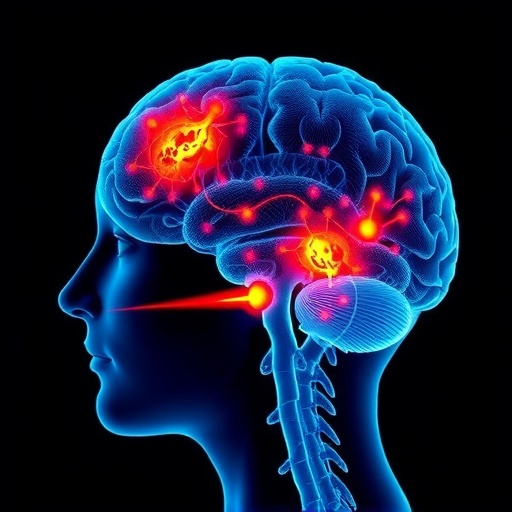Recent advancements in biomedical engineering have given rise to groundbreaking studies focused on understanding the mechanics of brain injuries caused by blunt impacts. In particular, the work presented by Galindo and Tartis provides pivotal insights into the acoustic detection of intracranial cavitation in polyacrylamide human head models. The importance of this research lies not only in its implications for sports-related concussions but also in wider applications, including military and automotive safety, where brain injuries from blunt force trauma are a significant concern.
The study explores the phenomenon of intracranial cavitation, which can occur when a sudden impact creates localized pressure changes within the skull. This pressure differential may give rise to bubbles of gas or vapor, leading to cavitation that can cause severe neural damage. By employing polyacrylamide models that simulate human head tissues, researchers were able to replicate the conditions under which these cavitation events occur, lending more robust validity to their findings. The implications of these engineered models are substantial, offering a true-to-life approximation of human responses to blunt impacts.
Employing advanced acoustic detection methodologies, Galindo and Tartis utilized sound waves to monitor the presence and development of cavitation in real time. By capturing the unique acoustic signatures associated with these bubbles, they have laid the groundwork for a non-invasive detection system that could eventually be implemented in sports, emergency medicine, and beyond. The potential for this technology to identify the onset of brain injuries during competitive sports is particularly tantalizing, offering a proactive approach to player safety.
This study stands out because it does not merely present theoretical findings; it includes empirical evidence demonstrating how orientation – the position of the head upon impact – influences the likelihood of cavitation. Through various impact simulations at different angles, the research provides real-world context for the application of their results. The findings suggest that certain orientations may significantly increase the risk of brain injury due to cavitation, prompting further investigations into protective headgear and safety measures that account for these factors.
One of the most exciting aspects of this research is the possibility for iterative improvements in safety equipment. By integrating the insights garnered from their models, manufacturers could design helmets that better protect against the specific conditions likely to produce cavitation. Traditional helmet designs may not take into account the vertical and horizontal forces experienced in various sports, but this study provides a foundational framework to create more specialized products that could mitigate these risks.
Moreover, the study calls attention to the underreported issue of mild traumatic brain injuries, which often go unrecognized yet can have long-lasting consequences. Thus, the importance of real-time detection systems based on acoustic signatures cannot be overstated. This technology could empower coaches and medical personnel to make immediate, informed decisions about a player’s fitness to continue participating in a game, thereby preventing further injury.
Additionally, this research has broader societal implications as it highlights the need for continued funding and support for evidence-based approaches to injury prevention. As awareness grows regarding the effects of concussions and other brain injuries, it becomes critical that we support scientific endeavors that seek to resolve these urgent health concerns. The outcomes of Galindo and Tartis provide a compelling case for the merits of further investment in similar research initiatives, which could pave the way for innovation in diagnostic techniques.
The methodology adopted by the researchers is equally compelling. Utilizing a combination of high-speed imaging and acoustic measurement technologies, their approach not only offers clarity in understanding how cavitation develops but is also replicable in different laboratory settings. This quality assures that future studies can build upon their findings with improved experimental designs and potentially broaden the understanding of the cerebral impact mechanics involved in blunt trauma.
As this research progresses, the hope is that it will inspire future studies aimed at developing more comprehensive models of head injuries. Collaborative efforts between engineers, medical professionals, and sports organizations could yield transformative solutions to enhance player safety in contact sports. Potentially, the findings might even sway regulatory bodies to mandate stricter guidelines surrounding equipment and player conduct, steering sports towards a safer future.
Another interesting dimension of this study is the investigation into the types of cavitation—namely, how varying impacts could create different cavitation dynamics depending on the nature of the force applied. Understanding the myriad variables influencing cavitation may lead to customized assessments of risk in individual athletes, taking into account their playing style and physical characteristics.
The societal and cultural implications of this work extend beyond just sports contexts, finding relevance in military applications where service members are frequently exposed to blunt force trauma. The ability to detect cavitation injuries in real-time could revolutionize evacuation and treatment protocols for soldiers, thus improving outcomes in traumatic brain injuries sustained in combat.
The urgency of developing such technologies cannot be understated, especially considering the alarming statistics surrounding concussions. Approximately 1.6 to 3.8 million sports-related concussions occur in the United States annually, highlighting an urgent need for improved detection methods that could lead to more effective treatment pathways.
In conclusion, the vision painted by Galindo and Tartis is one that seamlessly integrates advanced technology within the realms of healthcare and sports safety. As the work progresses toward clinical application, the hope is that these sophisticated systems will be embraced wholeheartedly by the sporting community. The road ahead may be intricate, but the potential outcomes promise not only enhanced safety for athletes but also a paradigm shift in how we approach brain injuries in various contexts.
Ultimately, the goal of this research is to foster a deeper understanding of head injuries and to arm medical personnel with the resources needed to respond effectively in the face of these challenges. By amplifying the acoustic detection of intracranial cavitation, Galindo and Tartis have positioned future studies to explore not just the onset of injuries, but intricate questions surrounding prevention, treatment, and rehabilitation efforts for affected individuals.
Strong collaborations in the scientific community will be essential in maximizing the impact of this work. The neural mechanisms of injury are complex and multifaceted; thus, engaging a diverse array of practitioners and researchers could provide even richer insights into the care and prevention of brain injuries. With our collective focus, we can look forward to an era where advancements like those proposed by Galindo and Tartis bring about meaningful change.
Subject of Research: Acoustic Detection of Intracranial Cavitation Induced by Blunt Impacts
Article Title: Acoustic Detection of Intracranial Cavitation Induced by Blunt Impacts in Polyacrylamide Human Head Models Across Varying Orientations
Article References: Galindo, E.J., Tartis, M.S. Acoustic Detection of Intracranial Cavitation Induced by Blunt Impacts in Polyacrylamide Human Head Models Across Varying Orientations. Ann Biomed Eng (2025). https://doi.org/10.1007/s10439-025-03895-9
Image Credits: AI Generated
DOI: https://doi.org/10.1007/s10439-025-03895-9
Keywords: Intracranial Cavitation, Acoustic Detection, Blunt Impact, Polyacrylamide Models, Brain Injury, Sports Safety, Biomedical Engineering, Concussions.
Tags: acoustic detection of brain injuriesadvanced acoustic methodologies in biomedical researchautomotive safety and brain traumabiomedical engineering in sports safetyblunt impact brain injury researchimplications of head injury research on safety standardsintracranial cavitation in head modelsmilitary applications of brain injury detectionneural damage from blunt force traumapolyacrylamide models for brain injury studiespressure changes in skull during impactsreal-time monitoring of cavitation events





